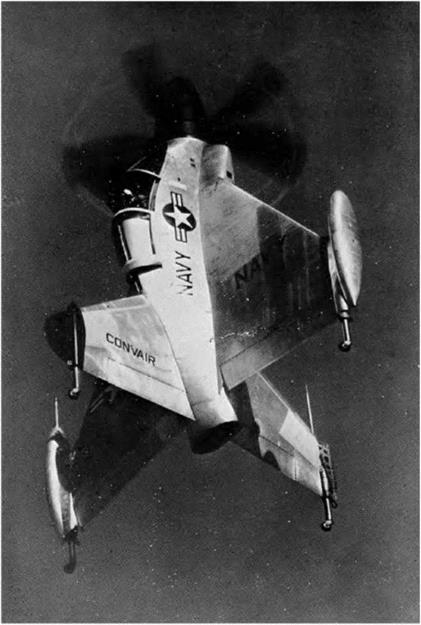Surface skimming vehicles
The hovercraft can reasonably be counted as a type of aeroplane, as it does fly, albeit just above the ground. The hovercraft is lifted above the ground or water surface by means of a fan, which produces a raised pressure under the vehicle. Leakage of the air from the underside is restricted by a peripheral
|
|
Fig 6E VTOL
(By courtesy of the General Dynamics Corporation, USA)
Pogo aircraft built for US Navy; after vertical take-off it could level off and fly horizontally; for landing the pilot pointed the nose straight up, and backed down tail first onto small wheels at trailing edges of wings and fins.
|
|
Fig 6F Convertiplane
(By courtesy of Bell Helicopter Textron)
The Boeing-Bell V-22 Osprey. Capable of VTOL and VSTOL. The engines can be rotated to provide conventional forward flight after take-off.
‘curtain’ of high speed air, normally supplemented by a flexible ‘skirt’. At one time, the hovercraft was seen as a major new type of transport vehicle, and for many years hovercraft operated a ferry service across the English Channel. In fine weather this provided a much faster alternative to the conventional ferries. However, the hovercraft were expensive to run and maintain. Also they could not be operated in very heavy seas, and were prone to generate nausea amongst the passengers even in moderate seas. Nowadays hovercraft are mostly used for very specialised operations, for example in swampy areas, and for recreational and competition use. For ferry duties, they have been largely superseded by various types of catamaran and hydrofoil.
Another type of vehicle that flies just above the surface is the surface skimmer or ekranoplane. These aircraft resemble a conventional aircraft, but by flying just above the surface, take advantage of the ‘ground effect’ which greatly reduces the wing downwash, and consequently reduces the accompanying trailing vortex drag. Some extremely large and very fast aircraft of this type were under development in the old Soviet Union just before its collapse, but subsequent economic difficulties brought further development to a virtual standstill. The main disadvantages of the ekranoplane are the problems of ensuring the correct ground clearance at all times, and the very large amount of engine power needed to get the aircraft to lift off from the water. Several large turbojets were needed on the larger experimental aircraft, and once liftoff had been achieved, most of them became redundant for the rest of the journey.













